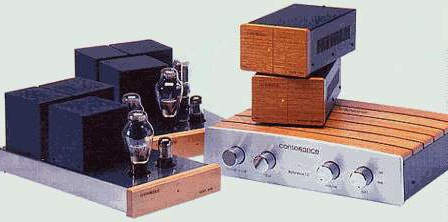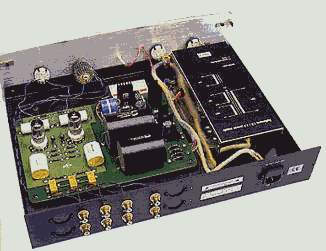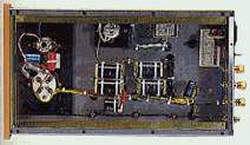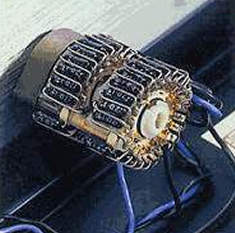| |
Translated from Image HiFi
6/2000
Valve Amplifiers by E.A.R.,
Opera Audio and Pear Audio
Words: Roland Kraft (translation T. Loesch), Photos:
Rolf Winter
The designers of this Valve Features participants
are Tim de Paravicini, Bojan Hajdinjak and Liu Zhao
Hui. This means made "made in England", "made in
Slowenia" and "made in China" - can it be any more
international?
The key info right at the start: Editor in Chief
Dirk Sommer feels that in this publication topics
other than "only" Valve Amplifiers should be covered.
A view not shared by the Author of these lines,
given that Valve Amplifiers are the second or third
nicest thing in the world. Still reality pressures
dictate that that in itself unnecessary Equipment
like transistors (yuck), 86-decibel loudspeakers
(aaaargh), 5000 deutschmark LP pickups (gulp), record
players without magnetic field bearings (bahhh),
CD-Players (PlayStation) and naturally Cables (okay...),
Features (7-Series without typeplate, oh god), Show
Reports (C.B. with O∩hEocha Design) and X-Files
(post nationalist meta vibes -- cool) must be published.
Which at the bottomline means that place for Valves
is lacking.
Longwinded, extremely difficult negotiations finally
resulted in the following: The Valve Feature appears
in instalments, planned are at the moment two parts,
the first you are reading now. We continue in the
next issue, though the ordered glassware could easily
last for another instalment. Also planned is a small
valve Journal and naturally a Internet report.
Test Valve Amplifiers Opera Audio Consonance
PM-1/Reference 1.0/M500
Price 15000 Mark
These units, phonostage, preamplifier, poweramplifier
-- hail from China, more precisely from Beijing.
They comply with the concept held by real Valve
enthusiasts, not unsurprisingly perhaps, given the
large number of High End activities in China. Starting
with the brief, but well written operating manuals
we can further note the clear electrical construction,
the high quality components and attractive casework.
The latter, accented with real wood helps specially
the preamplifer Reference 1.0 to a noble appearance.
For this unit we noted a surprising fighting weight
of 15 kilogram, caused first by the massive aluminium
front panels and secondly by a substantially overdimensioned
transformer ensemble. Contrary to the monoblock
poweramplifier's 每 more on this in a moment
每 the preamplifier is build on a printed circuit
board; two ECC82 double triodes grace the valve
sockets. Sporting only three inputs the Reference
1.0 is hardly a connection marvel; purists however
will not need any more and will rather point towards
the high karat ingredients of the Preamplifier.
These show themselves after lifting the wood clad
lid, where we must note with a wink that in Beijing
different views regarding the precise fit of screwholes
are held than over here. Yet we bear the fiddling
with composure and rather look at the Transformers
in their screening case and consider the fact that
the powersupply employs choke filtering. No less
surprising is the Volume control, consisting of
a multistep switch combined with noble resistors
and the fat Solen polypropylene powersupply capacitors
are used. The principle is becomes quickly clear:
extremely simple, feedback free circuit 每 only
two triode systems in standard circuits are in the
signalpath -- high quality components, excellent
powersupply. Sonically this way can result hardly
in anything wrong, specially with the critical coupling
capacitors coming from a well-known audiophile component
maker.
Structurally the 300B Monoblock poweramplifier's
follow suit; simplicity is the motto, bringing us
to the -- with single-ended amplifiers essential
-- choke filtered power supply. This naturally uses
a Valve rectifier; here we find a 5Z3 from Chinese
production in the socket; however internally this
unit reminds me strongly of the common 5U4. Used
as voltage amplifier/driver is the well-known 6SL7,
here in form of a JAN 6188 from American manufacture.
The only highlight for the circuit design is the
use of one triode as anode load for the other; in
America this is called "series amplifier" or "SRPP"
("shunt regulated push-pull"). This circuit offers
both adequate gain and low output impedance, as
it is well know that a large power triode is not
easy to get "into gear". Via the coupling capacitor
每 a polypropylene unit from Wima 每 we connect
to the grid of the dc heated 300B. The Chinese manufacturer
uses Valves from domestic manufacture, whose cathode
is connected symmetrically via two 20 Ohm resistors.
The correct operating point is achieved by the voltage
drop across a 1kOhm high power cathode resistor;
giving us the standard connection for most 300B
single-ended amplifiers.
Power
Transformer and filter choke are located below a
shielding cover -- this is technically more relevant
than a thick-walled case

By the way, "official" 300B's, oriented on the original
Western Electric Amplifier WE 91A use a difficult
to obtain 880 Ohm cathode resistor. In direct contrast
to the preamplifier, the two monoblocks have not
been constructed with audiophile components; instead
we find quite common components 每 except for
some (Chinese) resistors of a very antique looking
construction, known only to the historically interested
radio amateur. Not that it effects the function
in any negative way. The sonically critical heater
voltage for the directly heated 300B (heater = cathode)
is produced by a simple rectifier-capacitor circuit;
one often sees the well-loved 5V Regulator in this
position.
The abandoning of the integrated regulator and the
thus less stable heater voltage complies with the
views of some valve enthusiasts, who steadfast

The old motto of the "short signalpath" is taken
literally by this 300B Amplifier, more is not needed
for nine watt
maintain that a triode with unregulated and thus
passive heater supply sounds better.
A negative feedback loop between output transformer
and input stage is not diagnosed; the 300B fan's
see this with pleasure. No less of a pleasurable
view is presented by the pure ceramic valve sockets
and the absolute "high-end" binding posts for 4
Ohm and 8 Ohm loads. The placement of the power
switch directly on the back of the amplifier gives
however reason for criticism 每 it is simply
inconvenient having to bend and reach over the chassis
every time. All transformers have black covers,
three in number, if desired a further cover for
the valve ensemble can be used. Despite the only
twisted -- not shielded -- pair of input wires between
input connector and voltage amplifier the noise
levels of this amplifier are really fine. Lowther
equipped loudspeakers are offered from the same
German distributor, which are with more than 100
Decibel efficiency very sensitive to any hum or
hiss (we will soon report on these highly interesting
loudspeakers). Both the preamplifier and the poweramplifier's
from Opera Audio show themselves as exemplary quiet
-- compliment.
Finally, available optionally is a two part phonostage,
named PM-1, as a matter of course with wooden front
panels. One of the two enclosures' houses only the
powersupply, the voltages are connected via a special
connector. With a weight of nine kilograms for the
ensemble one not only notes the very strong enclosures
but also a hefty torroidal main's transformer with
powersupply regulation. The 1800 Mark phono-stage,
with reference to amplification and the 47kOhm input
impedance, is tailored to use of Moving Magnet Cartridges,
Moving Coil systems require a further stepup transformer.
The circuit is based on one ECC83 Triode per channel,
the two systems forming a two stage amplifier. The
RIAA Equalisation works as active, frequency dependent
negative feedback between amplifier output and the
cathode of the first valve; the removal of DC from
the feedback however requiring an extra coupling
capacitor on the output. A further (positive) feedback
loop connects the two triodes' cathodes, whose cathode
resistors are not capacitively decoupled. The manual
simply states "deep negative feedback" and quotes
a surprising 86db signal to noise ratio.
The Volume control is manufactured by hand and with
much effort from individual resistors - the steps
are o.k.

This then makes itself very positively known in
practical use, even if some radio frequency pickup
somewhat spoils the picture. However, in all fairness,
this illness is extremely dependent upon location
and is usually easily cured with a few picofarad
additional capacitance on the phono input.
When used as chain - phono-stage, preamplifier,
power-amplifier - the resulting overall gain is
notably on the high side. This manifests itself
thus that with a 96db sensitive speaker appropriate
for 300B's the 9-o'clock position of the volume
control leads to already high levels. Of very little
help here was the minus ten decibel gain switch,
this actually operates as muting switch and almost
completely kills the output. Should one use a MC
stepup transformer, a low stepup ratio should be
chosen. Yet, in the mentioned 9 o'clock volume control
setting no objectionable background noise could
be heard, illustrating the usability of this Chinese
system with high sensitivity speakers very successfully.
By the way, for the volume control: the fat, chrome
plated knobs on the preamplifier tend after a while
to get loose and turn on their axis - a small aesthetic
blemish easily solved by tightening the small screws
in the knows with a suitable Allen key.
Contrary to the small mechanical problems, these
Chinese units show that when it comes to making
music they can measure up without problems to the
big names in Valve Audio. Here the power amplifier
leaves some room for ones own experiments - instead
of the chinese300B any other version of the famous
triode can grace the socket. Appropriate pricewise
seemed a pair of Sovtek 300B's that worked well
with the power amplifier and offered more subtlety.
This means that the tow monoblocks using the standard
300B's played very powerful, big and quick footed,
offering through the bank an energy charged impression.
Feisty, and sometimes hairshirted the M500 offers
the warm fundament and the almost sleepwalker like
rhythmical surety known from other 300B concepts.
With that the Bass reaches comparatively low, which
says something about the quality of the output transformer.
With regard to detail and resolution in the treble
it is marvellously possible to live with the mono's
the way they come out of the box; if -- by the way
-- the basic condition - namely a lot of sensitivity
behind the amp - is fulfilled. With the Sovtek in
the socket the somewhat hairshirted tonal leaning
is exchanged for a trace of more charm and refinement
- a matter of taste, not the least determined by
the character of the Speaker used. The Sum then
as far as the power amplifier is concerned: a perfect
300B starter drug.
Accounting
for the almost classical recipe for success, namely
a simple valve circuit combined with an extensive
powersupply and high quality component, it is not
surprising that Reference 1.0 linestage preamplifier
delivers the goods. The preamplifier is exemplary
transparent, but clearly shows the use of valves,
thus sounds liquid, full of temperament, is never
aggressive, retains tonal colours and space, knows
neither hum or hiss and if one wants to find any
reason for complaint, one might find small issues
of microphony, but such an old topic for valve preamplifiers.
Short and sharp, a big recommendation, especially
in teamwork with CD Players. Okay, more is certainly
possible. This Chinese preamplifier stops on the
one before last (pressure) step in the Bass Basement,
but on the way down there neither contour nor control
is lacking. A little above this, the knife-edge
walk between fullness and precision succeeds greatly
and in the midrange others manage the famous tic
more liquidity, more expressiveness, more dynamic.
But, and that is the most important most important
question, at what (extra) cost? The fact is, in
this case the price/sound relation is incredibly
good and whoever wants more has look much further
up, among the super expensive monsters. A small
drop in tension, sorry in sound must be accepted
by those who extend their system with the PM-1
A small drop in tension, sorry in sound must be
accepted by those who extend their system with the
PM-1 Phonostage. Compared to the other players this
duo reveals itself as too pedantic, sometimes stoic.
Okay, all comes clearly etched, almost officially
fastidious, however also, yes, somehow totally unerotic.
Maybe some of the liquidity is missing, that the
charm of Valves was lost. As swinging and elastic
as the Pre/Power combo steps, as stiff, as braked
down is the presentation of this Phonostage. That
is despite the for Valves almost reverence inspiring
freedom from noise; despite clear plus points for
the rendition of space, which is stable, deep and
thus convincing. Both the impulsiveness and the
excellent timing abilities as well as the tension
build-up that the pre- and power-amplifier manage
so well are subdued; furthermore the rendering of
the low frequencies is less palpable and visceral.
This is not the least the result that now grey dominates
over deep black, that the low frequencies seem not
as far extended downwards. Non of this should be
seen as devastating criticism, but only as a note
that the phonostage plays below the level of other
components from the same house.
Image x-tract
For the money, that is dead sure, a fine combination;
if one listens very closely and can overlook minor
problems - all of mechanical nature -- that is.
Nothing for the soldiers of battles of mass and
overbuild among the Audiophiles. Yet sonically a
safe bet for valve novices, who may not have the
equivalent of a nice family saloon car to dispose
off, but also would like something better than the
average. My personal sonical extra tip are the 300B
monoblock amplifiers, which even equipped with china
triodes produce great fun - instead of expensive
valves better buy records!
image infos
Opera Audio Consonance Reference 1.0
Inputs............................... 3 X Line
Outputs............................. 1 X Line
Features...............................screte .......stepped
attenuator, mute-switch
.no negative feedback, choke filtering
Size (W/H/D)...............................3/32/10cm
Weight...............................15kg
Price...............................6900DM
Warranty...............................12 Month
Opera Audio Consonance M500
Power...........9 Watt (Manufacturers rating)
Output...........4/8 Ohm Bin
ding Post Inputs...............................4X
Line
Features........300B singleended ......Monoblock
with choke filtering ........and valve rectification
Size (W/H/D)............22/17/41cm
Weight...................15kg
Price......................6200DM
Warranty...................12 Month
image contact
Opera Audio - Boldyreff+Mende GdBR,
Beierheimer Allee 30, Karlsruhe;
Tel.: 0721/9665402;
www.operaaudio.de |
|